How Long After Shock Can You Swim?
Author: Chris Miller | Editor: Omar Alonso
Review & Research: Jen Worst & Chris Miller

Imagine coming from a long working day and going to the pool only to see algae contamination. The first thing that might come to your mind is to shock the pool to raise the free chlorine level for a beneficial purpose. You might be wondering, how long after shock can you swim or whether you can dive immediately.
You must not jump into the pool immediately after shock. The general rule is to wait for 24 hours and let the chlorine level drop to 5ppm or less. The time will vary depending on what chemicals you use and the amount as well.
Wait for the levels to even out to a safe limit so that it doesn't cause itching or irritation to the eye/skin. To know more about the shocking and safe time frame to enjoy the water, continue reading the article.
What is Shocking a Swimming Pool?
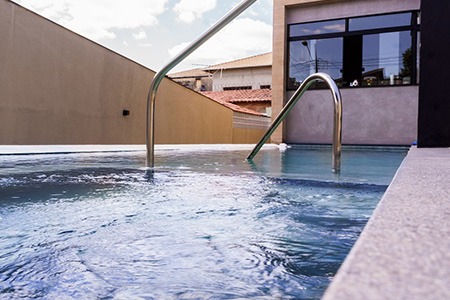
Swimming pool shock is simply the water treatment made to boost up the free chlorine in the water. What it does is it helps to kill all kinds of bacteria and algae in the pool, making it suitable for swimming purposes.
Proper shocking is needed at all costs, or else you’ll end up with pool water that can cause rashes, itching on the skin, and blurry eyes. Professional pool maintenance technicians consider 1-3 parts per million chlorine levels to be on the safe side to prevent any irritations.
Some common chemicals used to shock a pool are given below
- Calcium Hypochlorite
- Sodium Hypochlorite (Bleach Shock)
- Potassium peroxymonosulfate (Non-Chlorine Shock)
- Lithium Hypochlorite
- Sodium Dichlor
- Potassium Monopersulfate
There are many options, including these chlorine alternatives, though the most effective are listed above. You don't want to perform an ineffective job because you ultimately spend more money treating more frequently with worse chemicals.
How Long After Shock Can You Swim & How to Maintain Safety?

This will depend on the size of the water body. To be on the safe side, it is wise to wait for 24 hours after you've shocked the pool. Diving into the pool is highly discouraged because it might affect your skin and internal parts in the long run.
When using Sodium Dichlor or Calcium Hypochlorite, it is recommended to let it work for 8 hours before you can decide to jump into the water. The best you can do is to apply the treatment in the evening so that it gets time to work overnight and will be ready by morning.
Potassium Monosulfate, on the other hand, is a fast-acting agent and will take less time to recover. When treated with this chemical, you can get into the pool in 15-30 minutes.
Whatever solution you use, the Center for Disease Control (CDC) recommends waiting for a day as a safety measure. It is also advised that you check the ph and chlorine levels of the pool before swimming. The ideal ph level is between 7.2 to 7.8, and the chlorine level has to be between 1-4 parts per million.
So, how long after shocking your pool can you swim? "It depends" but the tried and true and easy-to-remember answer is 24 hours.
What Can Happen if You Enter the Pool Right After Shocking?
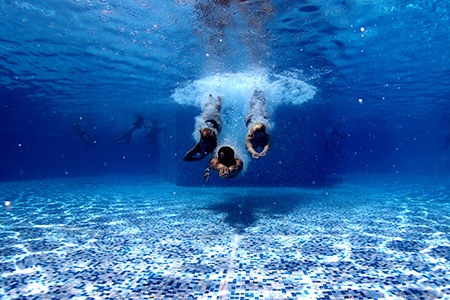
Believe it or not, most swimming-related irritation is due to exposure to imbalanced chlorine. It can affect a human in two ways: inhaling it or when it comes in contact with the skin. What to expect when you go to the pool right after shocking?
Well, as starters, you can end up with severe skin drying issues. Chlorine is very reactive with water and thus provides an acidic reaction. Not only that, the chemicals used to shock a pool will likely cause itching, burning eyes, and sometimes cause respiratory problems.
When inhaled, calcium hypochlorite is known to accumulate liquid inside the lung cavity, resulting in breathing issues. Sodium Dichlor is one reactive formula that can be explosive if not maintained properly. So it is advised to handle any chemicals with caution.
If you dive in a pool that has been shocked and you haven’t given it enough time to get back to normal, you’ll most likely experience skin trauma. In such cases, rinse the affected area with clean water immediately.
For respiratory problems, get out of the pool if you are feeling any discomfort and sit in an open area with enough ventilation. If the issue continues, seek medical help immediately. As always, the answer to "how long after shock can you swim" is 24 hours. Just wait it out, it's worth it.
What Happens if You Swim in a Pool With Elevated Chlorine Level?
If you haven't tested the pool water before diving in, there is a chance that you are getting exposed to an unwanted amount of chlorine, which can hamper your health.
To lower the chlorine levels, you might want to expose it to sunlight for some time (3 to 4 hours), which can cut out 90% of the chlorine levels. Changing water is another solution, but that will take time.
Once the new water is refilled, it is advised that you check the chemical levels, not only the chlorine but also calcium hardness and alkalinity. If you ask how long to wait after shocking your pool and it hasn't been 24 hours, don't be tempted to jump in yet.
Should You Run a Filter After Shocking a Pool & for How Long?
Yes, it's recommended that you should run your filter for a minimum of 8 hours after you shock the pool. This helps circulate the chemicals throughout the water and into the filter and pump as well, reducing any bacteria and algae in those and stopping it from being reintroduced to the swimming pool water later.
If you shock with the intention of treating algae then you should run the filter for a full 24 hours. This time is needed to help ensure the dissipation any pockets of shock that may be in the water. It can help to brush the bottom and sides of the pool, especially with a zero-entry swimming pool, to help stir up the algae and get it through the filter.
Why is the Pool Water Cloudy After Shocking?
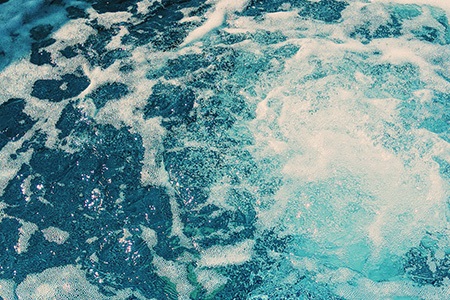
You can expect cloudy water after shocking, which signifies that the algae, bacteria, and other contaminants have died, unstuck from surfaces, and are suspended around in the water. Running the filter for 8 hours (or 24 hours if treating algae specifically) will reduce this cloudiness. Products such as clarifiers and flocculants can help clear up the water faster if you desire.
How to Shock a Pool Properly
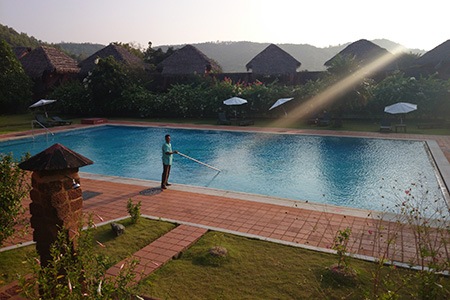
Applying shock might sound tough, but it is not as complicated as it sounds. This is what you can do.
1) First, check for the pH levels of your pool, no matter if it's shocked or not. Anything above 7.8 or below 7 might indicate that a shock is necessary.
2) Skim the debris and sediments from the water. Vacuum the surface to ensure no residues are attached to the walls and bottom of the surface.
3) When applying shock, it is crucial to maintain safety. You must have gloves, protective cloth, and goggles.
4) Make the shock formula beforehand. Use 5 gallons of water from the pool and add the shock solutions to it. Mix well, and it should be ready to be applied.
5) Take the bucket and pour the mixture onto the water surface. Make sure you cover all the edges of the pool. You won't need to drop the mixture in the middle; just ensure proper coverage on the sides of the pool.
6) When dropping the shock chemicals on the pool, make sure the water pump is constantly running.
7) Keep the water pump running for around 8 hours before you examine the water pH level. As we said, pool shocking takes time and if you are impatient to jump into the water, at least make sure the pH levels are good for you to go.
But, as we’ve stated once, and we’ll say it again, it’s better to wait for a day. When can you swim after shocking a pool? A full 24 hour day is the answer and we'll keep repeating it. It is the safest route to take and avoid any kind of physical problem. After that, your pool should be ready for swimming.
When to Shock a Pool
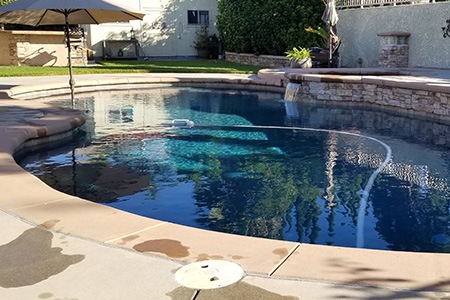
Maintaining the pool and even any types of hot tubs has to be your top priority; in that case, it is best to have it checked and shocked in times such as:
Before the First Dive
It is vital to shock the waters before the first dive and not to mention the pool season closing time. So that the next time you use the pool, it’ll be somewhat fresh.
After a Storm
When a storm passes by, you must make sure the pool waters are unaffected. In most stormy situations, the waterbody will be contaminated and will deserve cleaning and shocking for safety.
After a Pool Party
After-party shocking is necessary because pool waters will catch a lot of bacteria and germs after extensive use. So shocking can bring back the stability of the chemical levels.
Summer Days
Summer Heat can affect the chlorine level and bump it up to the next level. Heat usually catalyzes the chlorine reaction, which can be harmful. So it's ideal to have the water shocked on summer days.
How Long After Shock Can You Swim? 24 Hours!

Owning a pool in your backyard is super fun. To have a functional fool, it is customary to maintain it daily. Leaving it unused and exposed to weather will change the ph balance making it unusable. Algae build-up and bacteria formation is a common occurrences and can be frustrating.
Applying shock is the only way to deal with the unwanted hassle. Can you swim after shocking a pool? Some people have been confused with the time frame of shock treatment and have been flooding questions like, how long after after shock can you swim? The answer is 24 hours to ensure safe swimming.
A swimming pool can be ready even before 24 hours, depending on the size of the pool and the amount of which chemicals used. But to play it safe, the answer to "how long after shock can you swim" is always 24 hours. The next time you apply shock treatment to the waters, just be patient and let it work without disruption before you step in. You don't want to damage your skin or eyes, do you?



